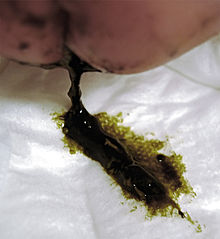Meconium
The meconium - in German-speaking countries also called Kindspech , in animals called Gutpech - is the first stool of a newborn .
Meconium is not actually a digestive end product ( faeces , stool), but a tough, dark mass of peeled-off epithelium of the mucous membranes , thickened bile and hair and skin cells swallowed with the amniotic fluid . Typically, meconium is excreted in the first 24–48 hours of a child's life. When eating in the form of breast milk or other infant formula , faeces are produced in the following days, which follow the meconium in the excretion.
A lack of meconium indicates an intestinal obstruction ( meconium ileus , occurs in cystic fibrosis , for example ), a passage disorder or Hirschsprung's disease .
Normally, the amniotic fluid in a pregnant woman is clear, but the meconium in the unborn child can pass prematurely into the amniotic fluid in the womb . The dreaded complication is the meconium aspiration syndrome ( inhalation of the green amniotic fluid by the unborn child). In general, amniotic fluid containing mekonium is a pathological (diseased) finding.
The meconium is also an effective means of detecting drug abuse during pregnancy. The meconium accumulates toxic substances over a long period of time.
Clinical pictures
Meconium of butterflies
Meconium is also used to describe the excretion of metabolic products from pupae in butterflies after hatching. The German name for it is Puppenharn.
Individual evidence
- ^ Roche Lexicon Medicine, 3rd edition, Urban & Schwarzenberg Verlag Munich
- ↑ LADR range of services: synthetic amphetamines
